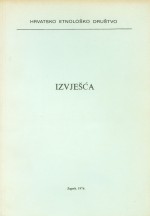Istarsko pučko lončarstvo
Istrian Folk Pottery
Author(s): Josip MilićevićSubject(s): Customs / Folklore, Ethnohistory, Recent History (1900 till today), Cultural Anthropology / Ethnology, Rural and urban sociology, 19th Century
Published by: Hrvatsko etnološko društvo
Keywords: Istria; folk pottery; Rakalj village; potter's wheel; clay cuts spirally laid; cultural ethnology;
Summary/Abstract: This paper is dedicated to 80th birth anniversary of Dr. Milovan Gavazzi. It only shows the results of the present research into Istrian folk pottery and it will be soon supplemented. The present research has proved only four production centers, but according to the forms, work technology and the number of the examples found we have to realize that there must have been more of them from the Age of Bronze, the Middle Ages until the present. The most famous and the most numerous ones belong to the village of Rakalj in the south of Istria. They are made manually on potter's wheel in the technique of clay cuts spirally laid. One woman in Rakalj produces them still today. The pottery products from Rakalj have been sold every where in Istria, even in distant places in the north and they have been preserved in great numbers in all Istrian museums. The pottery products from the village of Čukarija at Hum in northern Istria, are made with a foot-pedaled potter's wheel and they are formed out of one piece. At the contrary from those from Rakalj they are decorated with relief ornaments and scratchings on a wet pot. As a rule they were dated and initialed by the author so there are museum samples which are more than 160 years old. They were sold on the narrow territory of northern and middle Istria Nobody has made pots in Čukarija for more than 15 years, but even in the past it used to. be a hereditary profession in the family. Until World War II in the village of Pavletiči at Oprtalj , also in northern Istria, there used to make earthenware which was sold near Oprtalj . There are no necessary data about this production as the village and the villagers were destroyed in the war. There are only few of these pots in Istrian museums. Before World War II earthenware used to be also produced in Zubine village not far from Pavletiči. Their existence has been proved through literature but no samples have been found. Main feature of all Istrian village pottery is simplicity in production, few ornaments and no finishing, but sophisticated forms show an exceptional creative quality of folk skilled workmen.
Journal: Etnološka tribina : Godišnjak Hrvatskog etnološkog društva
- Issue Year: 1976
- Issue No: 5-6
- Page Range: 89-101
- Page Count: 13
- Language: Croatian

